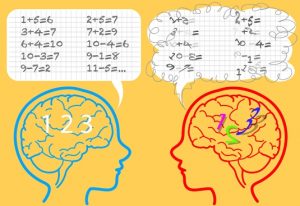by Amanda Morin
Reprinted from Understood.org

There’s not as much research on dyscalculia as there is on other learning and attention issues, like dyslexia or ADHD. But there’s a lot that researchers do know that can help debunk misconceptions about dyscalculia. Here’s the truth behind seven dyscalculia myths.
Myth #1: Dyscalculia isn’t very common.
Fact: Dyscalculia isn’t talked about as much as other learning issues like dyslexia. But that doesn’t mean it’s uncommon. In fact, experts say dyscalculia may be just as common as dyslexia. They also often co-occur.
Find out why dyslexia is diagnosed more often than dyscalculia.
Myth #2: Dyscalculia is “math dyslexia.”
Fact: You may hear people use terms like number dyslexia, math dyslexia, or numerical dyslexia to talk about dyscalculia. That might be because people think dyscalculia is all about reversing numbers. But just like dyslexia typically isn’t an issue of reversing letters, dyscalculia is something else, too.
Dyscalculia causes challenges with number sense and other math concepts. It’s very different from dyslexia, which is a language-based issue.
Myth #3: Kids with dyscalculia are “just being lazy.”
Fact: Kids don’t have dyscalculia because they’re not trying hard enough. In fact, many kids with dyscalculia are trying as hard as they can to get better at math. We don’t know exactly what causes dyscalculia. But research shows it’s related to differences in the brain—differences that kids can’t control.
Dyscalculia tends to run in families, too, which suggests that genes play a role.
Myth #4: Dyscalculia doesn’t show up until grade school.
Fact: Signs of dyscalculia can show up as early as preschool. That’s because dyscalculia can affect basic math skills, like learning to count. Other early signs include difficulty recognizing patterns and not being able to connect a number to an object. (Like not knowing that “5” applies to groups of things like 5 cookies, 5 cars, or 5 blocks.)
Myth #5: All kids with dyscalculia have the same difficulties with math.
Fact: Dyscalculia can look different in every child. One child’s trouble spots may be different from another child’s. Some kids have trouble with working memory, which can make it hard to do multi-step math problems. Others may have trouble grasping information shown on charts or graphs.
Most kids with dyscalculia do have one thing in common, though: trouble remembering basic math facts and doing math problems.
Myth #6: Dyscalculia is another name for math anxiety.
Fact: Dyscalculia and math anxiety aren’t the same thing. Many people feel anxious about math, even when they don’t have dyscalculia. The difference is that people with dyscalculia also struggle with the skills to do math problems, which can be related to their anxiety.
Compare the signs of dyscalculia and math anxiety.
Myth #7: Kids with dyscalculia can’t learn math.
Fact: Kids with dyscalculia may have a harder time learning math than other kids. But that doesn’t mean they can’t learn it—and be good at it. With good instruction and practice, kids with dyscalculia can make lasting strides in math.
Many kids benefit from multisensory instruction. This type of teaching uses sight, sound and touch to help with learning. There are also classroom accommodations and other strategies that can help, like using graphic organizers.
By understanding dyscalculia, you can help debunk common myths like these. What other myths have you heard? Add them to the comments below. Then read what a mom wishes other people knew about parenting a child with dyscalculia.



